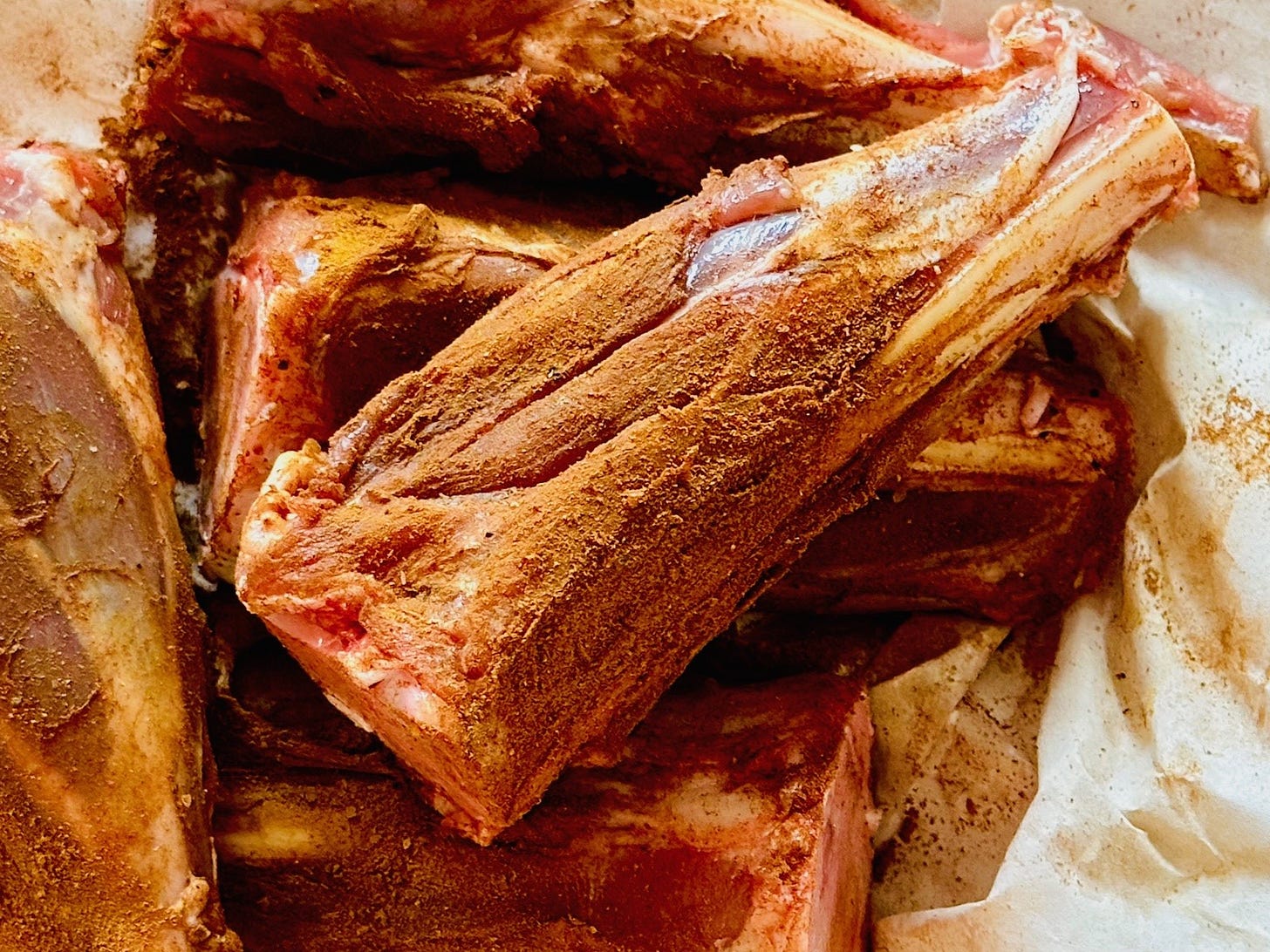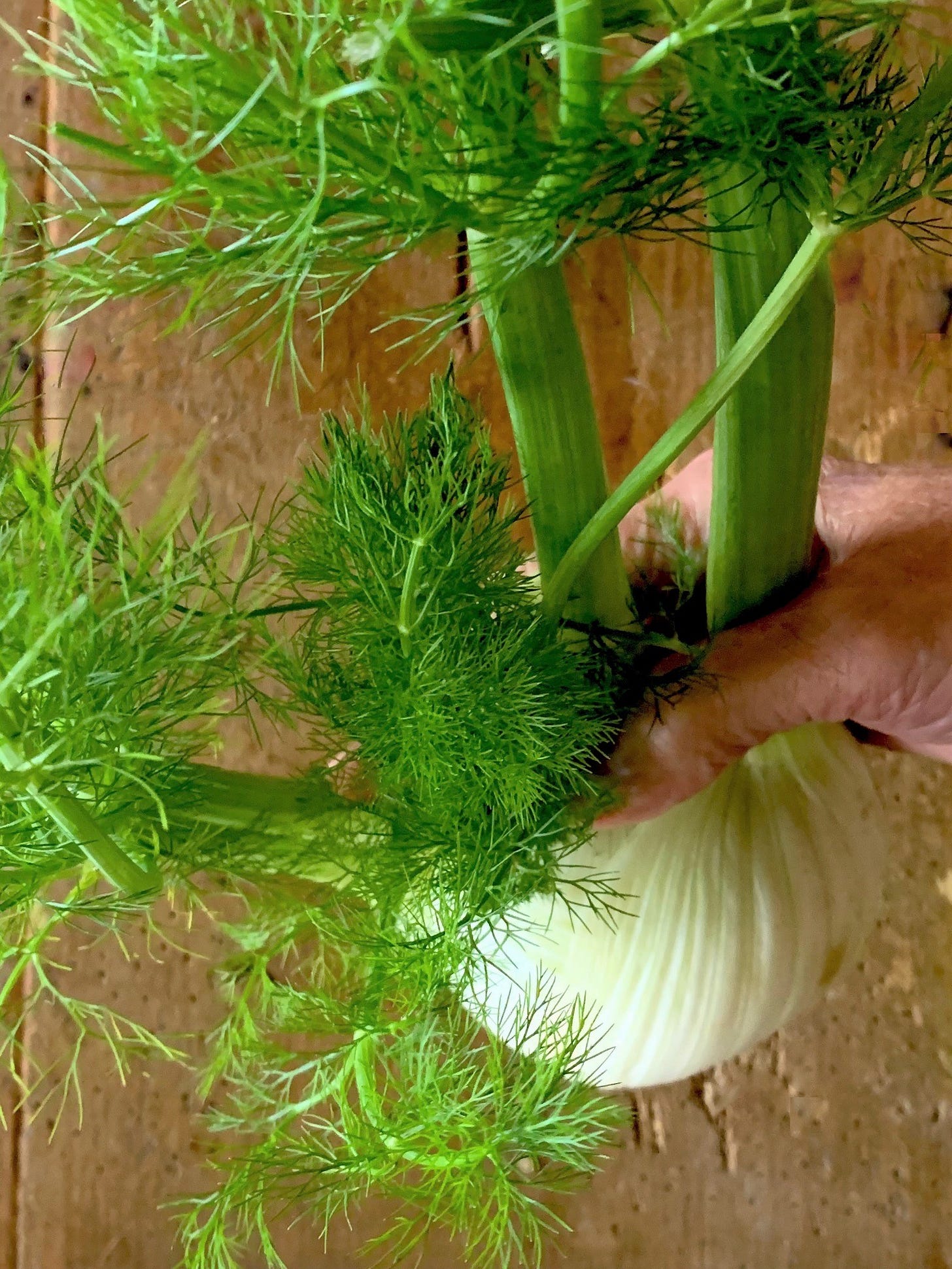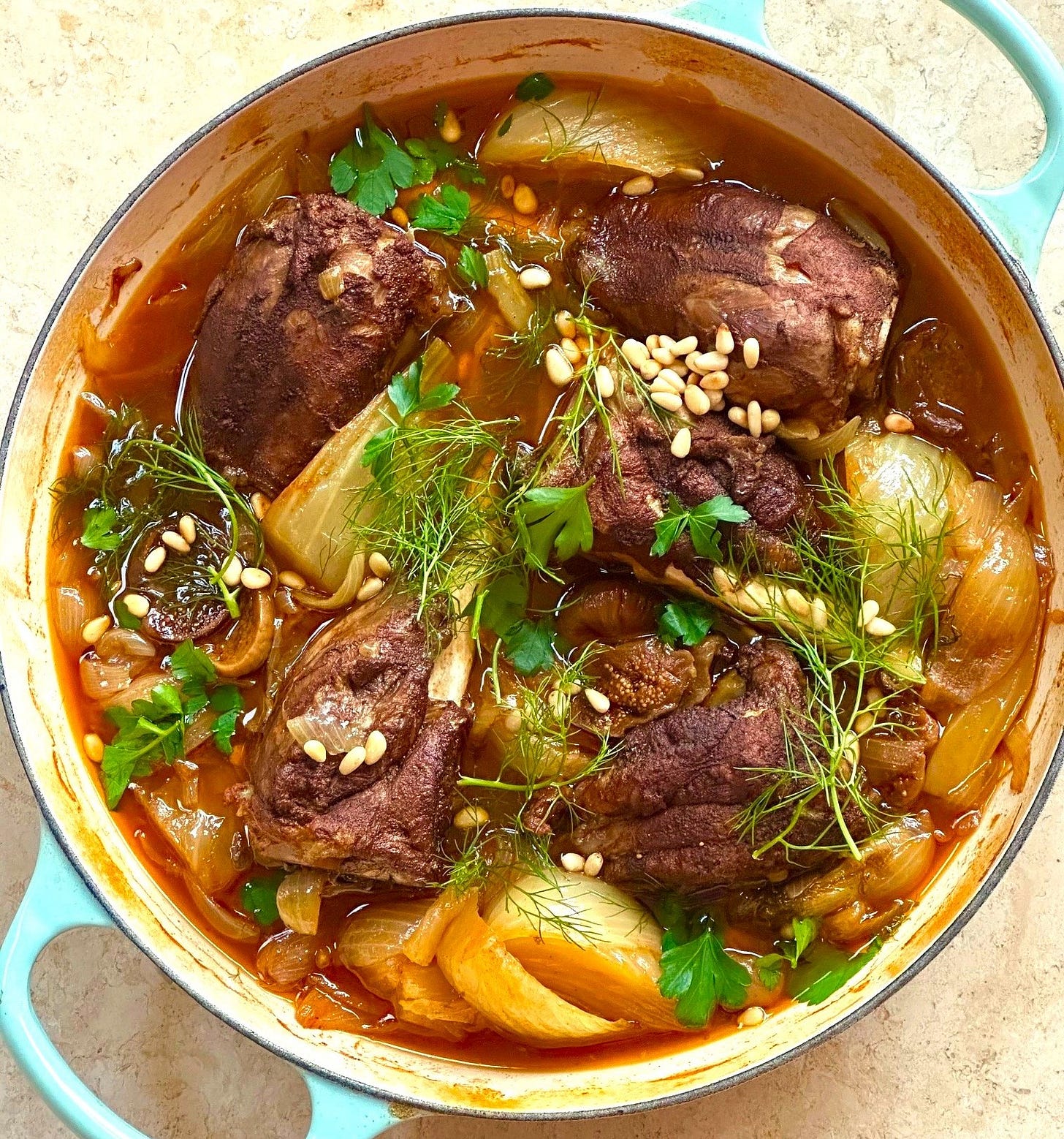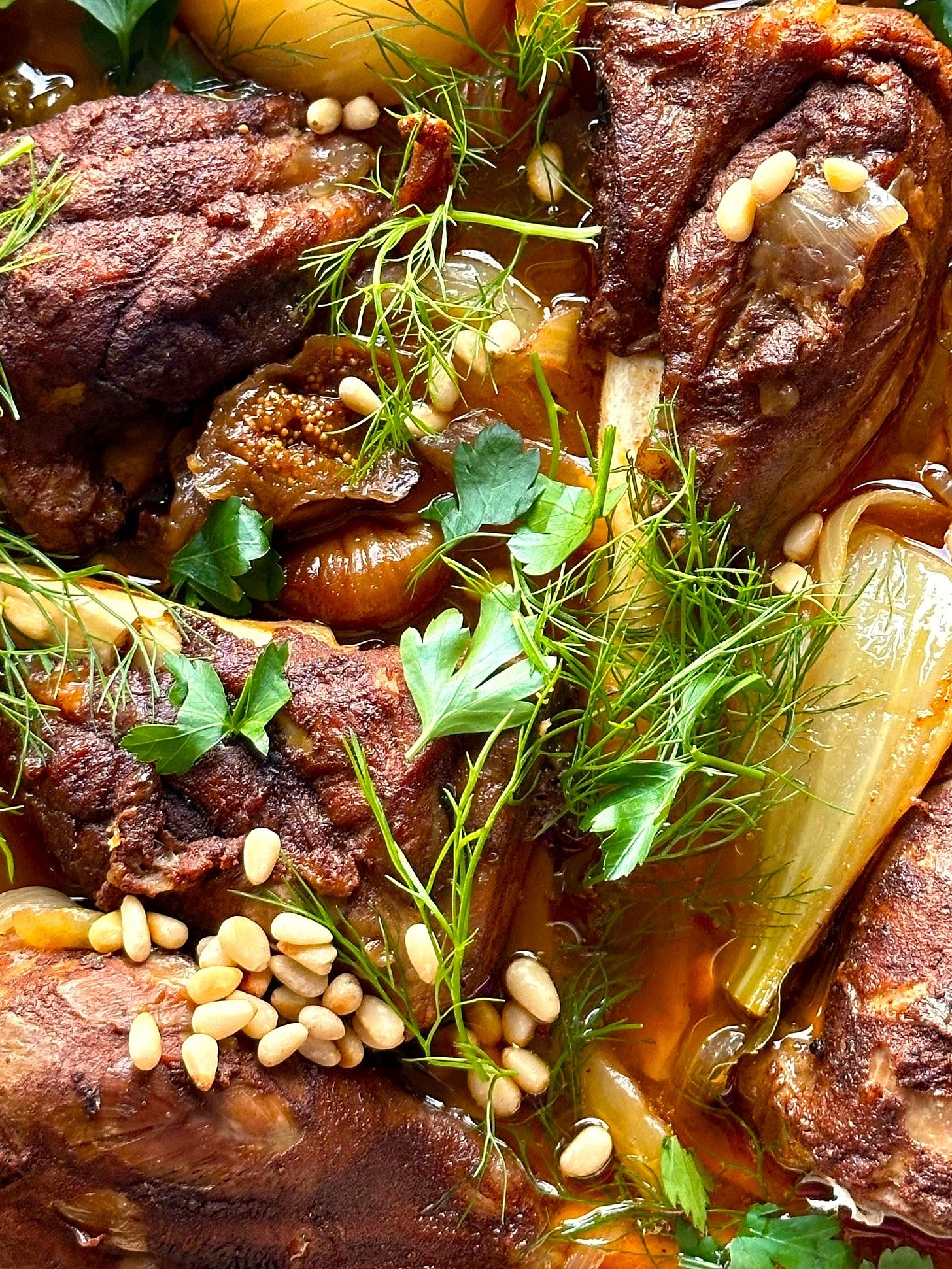THE LAMB SHANK REDEMPTION
Bringing grace and salvation to the humble lamb shank, via fennel and figs.
Lamb shanks have been off my dance card for years. Too fatty, too gross. Love lamb, just don’t need the fat.
But in the interests of revisiting my prejudices and reviewing them every few years, and with considerable pressure from those nearest and dearest to me, I have started enjoying them anew.
The collagen-rich meat is quite beautiful, and they are brilliant in how they take on all the flavours they are cooked with. And really, they are so alarmingly filling, it’s easy to balance out the meat component with loads of aromatics and vegetables.
ALSO: FRENCHING
That’s the culinary term given for trimming so that the bone is exposed, for a more elegant presentation, and to get rid of excess fat. (Hark - that sound? It’s members of my sheep-farming family scoffing about getting rid of all that lovely fat they spend their days putting on the lambs in the first place).
I cooked up some Frenched lamb shanks, and very much enjoyed the lighter, less fatty result. But I’m wondering if shanks are as fatty as they used to be anyway. You probably don’t really need to French them - and you do lose a bit of meat in the process.
A better way to monitor the level of fattiness is to simply cook the shanks the day before eating. Cool overnight and the fat will set on top like ice over a pond, so you can choose to remove some or all of it as you so desire.
This is known in the household as The Lamb Shank Redemption, a phrase that made me laugh as it popped into my brain. Then, because I don’t trust my brain at all, I googled it. (I do this with most things I come up with that I think are brilliantly original, and it is it very lowering to discover how almost everything has been done before).
Did you know, she says, aghast, that there is an entire cook book titled The Lamb Shank Redemption, devoted to recipes inspired by movie titles? Dishes include The Silence of the Clams, Frying Nemo, The Hummus Crown Affair, Pinenuts of the Caribbean, Cook-a-Dahl Dundee, and The Gnocchi Horror Show.
And then I remembered where the phrase had first lodged in the dusty cupboards of my mind. The lovely Martin Benn and Vicki Wild – Australia’s ultimate chef/restaurateur partnership - wrote a fabulous cook book last year called The Dinner Party. Their recipe for lamb shanks with pomegranate and charred cayenne peppers takes the humble shank to another level – and guess what they called it.
I should have remembered sooner, because they had very nicely asked me to work with them on the words for the book. It was an easy gig, because they didn’t need much help at all. Their spirit and hospitality and amazing stories and fabulous tips and humour were already all there. Basically, all I did to their immaculate manuscript was French it – trim it of a little extraneous fat to make it easier to appreciate the meat.
AY, THERE’S THE RUB.
I’ve used Middle Eastern spices here in a quick spice rub because they are so warm and warming. Rub it all over the shanks then leave for an hour, a few hours or overnight to work its magic.
You can also roll the shanks in flour before browning, which might help thicken the sauce a little as it cooks.
You will be tempted to add enough liquid to cover the shanks for their long slow braise, but back away. As long as they have stock half way up their sides and the pan is tightly covered, they will happily cook away in the resulting steaminess.
And if you do relent and add more liquid – and your resulting sauce is a bit thin – then just pour off the sauce and reduce it in a small pan by at least one third, then return it to the shanks.
The sauce doesn’t need to be dark, glossy and heavy; keep it light and enough to have fun with the rice, mashed potatoes or your choice of partner.
THE WILD CARDS: FENNEL AND FIGS
The fennel really makes this dish; with its lightly aniseedy flavour, and silken, ridged textures. Okay, there are people out there who don’t like fennel - I see you, and suggest replacing with lengths of leek, or carrots, or chunks of swede or potato.
Here’s how to chop the fennel for this dish: trim the root but keep enough of it to hold the fennel together. Cut in half lengthwise, then cut each half lengthwise into three pieces. AND KEEP THE FRONDS! Apologies for yelling, but they will be stunning strewn over the top to serve. And the dried figs bring a fruity seediness that just seems to go with everything else.
THE LEFT-OVERS
If you have a spare shank or two left over, pull the meat from the bone, shred it into some of the left-over sauce, and freeze for a future pasta sauce or pie filling. If there’s not enough for that, use it the next day to stuff a jaffle or toastie with some sauerkraut and cheese, for a Reubenesque office lunch.
LAMB SHANKS WITH FENNEL AND FIGS
One lamb shank per person is enough if they are nice and meaty. If smaller and Frenched, have a couple of spares. Serves four
4 to 6 lamb shanks, Frenched or not
2 to 4 tbsp olive oil
For the rub: 1 tsp cinnamon, 1 tsp cumin, 1 tsp paprika, 1 tsp turmeric, 1 tsp salt, half tsp pepper
2 onions, chopped
2 cloves of garlic, grated
2 fennel bulbs (keep the fronds)
1 cup white wine or water
750 ml stock or stock/water
2 tbsp tomato paste
100 g dried figs, halved
2 bay leaves
2 tsp ground cumin
1 tsp smoked paprika
1 tsp sea salt, half tsp pepper
3 tbsp finely chopped parsley
1 tbsp toasted pine nuts
For the spice rub, combine cinnamon, cumin, paprika, turmeric, salt and pepper.
Coat the lamb shanks with 1 tbsp olive oil, and rub the spices into the meat. You can do this the night before, or an hour before.
Heat the oven to 170C.
In a heavy pan, heat 1 tbsp olive oil and brown the lamb shanks well, turning often (do two at a time).
Remove the lamb shanks. If the spices have burnt in the pan, clean it and return to the heat.
Add 1 tbsp oil and cook the onions for 10 minutes until softened but not browned.
Cut the fennel in half lengthwise, and each half into three pieces, joined by the root.
Tuck in the fennel pieces and cook for 3 minutes to get them started. Add the white wine and allow to bubble and reduce by half.
Add stock or water, tomato paste, garlic, dried figs, bay leaves, cumin, paprika, and salt and pepper, and bring up to a simmer.
Return the lamb shanks to the pan and cook through for 10 minutes, skimming if necessary.
Cover and transfer to the oven for a good two hours, then test the meat for tenderness. It could take another 30 minutes or so.
To serve, add half the parsley to the shanks. Gently ladle each shank to a warm serving plate or shallow pasta bowl, and ladle fennel and sauce around. Finish with remaining parsley and fennel fronds and toasted pine nuts.
Serve with rice, mashed potato ( mashed sweet potato is adorable), orzo or similar.
Thanks for dropping by! And as always, thanks for your comments and suggestions. Special thanks to Terry for being (as you possibly guessed) the euphemistic “those nearest and dearest to me” who applied the appropriate pressure to make me reconsider the role of lamb shanks in my life.
I would also like to acknowledge the traditional owners of the lands and waters upon which I work, live, cook and play; the Gadigal people of the Eora Nation, and pay my respects to Elders past and present, and to the continuing strength and resilience of First Nations people, communities and cultures.








You’re always one step ahead of me. Meat free leftovers from an uneventful Fennel and Orange Lamb Shank Tagine are on the menu tonight. I thought I try a take on a Shakshuka. Not hopeful.
Well you got me at Lamb Shanks! Your recipe sounds amazing and of course I have saved to my Good Food file, albeit I really think I need to set up a Jill Dupleix folder so they don’t get lost.